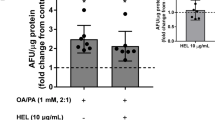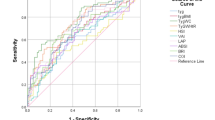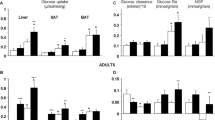Abstract
Objective:
Oral supplements of fenugreek (Trigonella foenum graecum) seeds (Fen) have been shown to treat glucose and lipid homeostasis in several metabolic disorders; however, its ability to alleviate obesity-associated pathologies is not known. The main objective of this study was to evaluate the effect of Fen in Zucker obese rats (Ob), an animal model of obesity and related disorders, such as dyslipidemia and hepatic steatosis.
Methods:
Female Zucker (6-week-old) Ob and lean (Ln) rats were randomly grouped (n=8 rats/group) to receive either basal or 5% Fen-supplemented AIN-93G diets for 8 weeks, and then were euthanized. Histopathology and biochemical parameters in the liver together with plasma biochemistry were assessed.
Results:
Obese rats had significantly higher (P<0.05) body and liver weight, as well as plasma insulin, lactate, cholesterol, triglyceride and tumor necrosis factor (TNF)-α compared to their Ln counterparts. Fen significantly reduced (P<0.05) the liver-weight of Ob rats in comparison to Ob rats fed basal diet (Control), while no effect was observed in the Ln rats. Fen treatment resulted in a lower P-value (P<0.05). In addition, Ob rats on Fen-supplemented diets had fasting plama cholesterol and TNF-α levels, and significantly higher (P<0.05) triglycerides in comparison to the control rats. Hepatic triglyceride level was significantly lower (P<0.05) in Ob rats fed Fen supplemented diets in comparison to control. The levels of bound and soluble liver TNF-α (26 and 17 kDa, respectively) and TNF receptor-II (TNFR-II, 75 kDa) proteins were significantly lower (P<0.05) in Ob than in Ln rats. Fen significantly lowered (P<0.05) both the soluble and bound forms of TNF-α protein while significantly elevating (P<0.05) TNFR-II in the livers of Ob rats compared to Ob Controls.
Conclusion:
These results demonstrate unequivocally that in a short-term preclinical evaluation, dietary Fen supplementation reduced the triglyceride accumulation in the liver, a hallmark feature of hepatic steatosis without affecting the plasma insulin or glucose levels in Zucker obese rats and suggest that TNF-α may play an important role in this process.
This is a preview of subscription content, access via your institution
Access options
Subscribe to this journal
Receive 12 print issues and online access
$259.00 per year
only $21.58 per issue
Buy this article
- Purchase on SpringerLink
- Instant access to full article PDF
Prices may be subject to local taxes which are calculated during checkout




Similar content being viewed by others
References
Kushner RF . Medical management of obesity. Semin Gastrointest Dis 2002; 13: 123–132.
Bessessen DH, Kushner RF . Evaluation and management of obesity. Hanley & Belfus Inc: Philadelphia, PA, 2002.
Bray GA . The Zucker-fatty rat: a review. Fed Proc 1977; 36: 148–153.
Zucker LM, Antoniades H . Insulin and obesity in the Zucker genetically obese rat ‘fatty’. Endocrinology 1972; 90: 1320–1330.
Chanussot F, Ulmer M, Ratanasavanh R, Max JP, Debry G . Influence of diet composition on obesity, hyperlipemia and liver steatosis in Zucker fa/fa rats pair-fed with Zucker Fa/− rats. Int J Obes 1984; 8: 259–270.
Krief S, Bazin R . Genetic obesity: is the defect in the sympathetic nervous system? A review through developmental studies in the preobese Zucker rat. Proc Soc Exp Biol Med 1991; 198: 528–538.
McCaleb ML, Sredy J . Metabolic abnormalities of the hyperglycemic obese Zucker rat. Metabolism 1992; 41: 522–525.
Hotamisligil GS, Shargill NS, Spiegelman BM . Adipose expression of tumor necrosis factor-alpha: direct role in obesity-linked insulin resistance. Science 1993; 259: 87–91.
Liu RH, Mizuta M, Kurose T, Matsukura S . Early events involved in the development of insulin resistance in Zucker fatty rat. Int J Obes Relat Metab Disord 2002; 26: 318–326.
Cheung AT, Ree D, Kolls JK, Fuselier J, Coy DH, Bryer-Ash M . An in vivo model for elucidation of the mechanism of tumor necrosis factor-alpha (TNF-alpha)-induced insulin resistance: evidence for differential regulation of insulin signaling by TNF-alpha. Endocrinology 1998; 139: 4928–4935.
Diehl AM . Tumor necrosis factor and its potential role in insulin resistance and nonalcoholic fatty liver disease. Clin Liver Dis 2004; 8: 619–638.
Valette G, Sauvaire Y, Baccou JC, Ribes G . Hypocholesterolaemic effect of fenugreek seeds in dogs. Atherosclerosis 1984; 50: 105–111.
Sauvaire Y, Ribes G, Baccou JC, Loubatieeres-Mariani MM . Implication of steroid saponins and sapogenins in the hypocholesterolemic effect of fenugreek. Lipids 1991; 26: 191–197.
Stark A, Madar Z . The effect of an ethanol extract derived from fenugreek (Trigonella foenum-graecum) on bile acid absorption and cholesterol levels in rats. Br J Nutr 1993; 69: 277–287.
Sharma RD, Raghuram TC, Rao NS . Effect of fenugreek seeds on blood glucose and serum lipids in type I diabetes. Eur J Clin Nutr 1990; 44: 301–306.
Bordia A, Verma SK, Srivastava KC . Effect of ginger (Zingiber officinale Rosc.) and fenugreek (Trigonella foenumgraecum L.) on blood lipids, blood sugar and platelet aggregation in patients with coronary artery disease. Prostaglandins Leukotrikens Essential Fatty Acids 1997; 56: 379–384.
Sowmya P, Rajyalakshmi P . Hypocholesterolemic effect of germinated fenugreek seeds in human subjects. Plant Foods Hum Nutr 1999; 53: 359–365.
Gupta A, Gupta R, Lal B . Effect of Trigonella foenum-graecum (fenugreek) seeds on glycaemic control and insulin resistance in type 2 diabetes mellitus: a double blind placebo controlled study. J Assoc Physicians India 2001; 49: 1057–1061.
Basch E, Ulbricht C, Kuo G, Szapary P, Smith M . Therapeutic applications of fenugreek. Altern Med Rev 2003; 8: 20–27.
Cicero AF, Derosa G, Gaddi A . What do herbalists suggest to diabetic patients in order to improve glycemic control? Evaluation of scientific evidence and potential risks. Acta Diabetol 2004; 41: 91–98.
Taylor WG, Elder JL, Chang PR, Richards KW . Microdetermination of diosgenin from fenugreek (Trigonella foenum-graecum) seeds. J Agric Food Chem 2000; 48: 5206–5210.
Juarez-Oropeza MA, Diaz-Zagoya JC, Rabinowitz JL . In vivo and in vitro studies of hypocholesterolemic effects of diosgenin in rats. Int J Biochem 1987; 19: 679–683.
Raju J, Patlolla JM, Swamy MV, Rao CV . Diosgenin, a steroid saponin of Trigonella foenum graecum (Fenugreek), inhibits azoxymethane-induced aberrant crypt foci formation in F344 rats and induces apoptosis in HT-29 human colon cancer cells. Cancer Epidemiol Biomarkers Prev 2004; 13: 1392–1398.
Corbiere C, Liagre B, Terro F, Beneytout JL . Induction of antiproliferative effect by diosgenin through activation of p53, release of apoptosis-inducing factor (AIF) and modulation of caspase-3 activity in different human cancer cells. Cell Res 2004; 14: 188–196.
Sauvaire Y, Petit P, Broca C, Manteghetti M, Baissac Y, Fernandez-Alvarez J et al. 4-Hydroxyisoleucine: a novel amino acid potentiator of insulin secretion. Diabetes 1998; 47: 206–210.
American Institute of Nutrition. Report of the ad hoc committee on standards for nutrition studies. J Nutr 1993; 123: 1939–1951.
Raju J, Gupta D, Rao AR, Yadava PK, Baquer NZ . Trigonella foenum graecum (fenugreek) seed powder improves glucose homeostasis in alloxan diabetic rat tissues by reversing the altered glycolytic, gluconeogenic and lipogenic enzymes. Mol Cell Biochem 2001; 224: 45–51.
Thakran S, Salimuddin, Baquer NZ . Oral administration of orthovanadate and Trigonella foenum graecum seed power restore the activities of mitochondrial enzymes in tissues of alloxan-induced diabetic rats. Mol Cell Biochem 2003; 247: 45–53.
Yadav UC, Moorthy K, Baquer NZ . Effects of sodium-orthovanadate and Trigonella foenum-graecum seeds on hepatic and renal lipogenic enzymes and lipid profile during alloxan diabetes. J Biosci 2004; 29: 81–91.
Muralidhara, Narasimhamurthy K, Viswanatha S, Ramesh BS . Acute and subchronic toxicity assessment of debitterized fenugreek powder in the mouse and rat. Food Chem Toxicol 1999; 37: 831–838.
Li Z, Yang S, Lin H, Huang J, Watkins PA, Moser AB et al. Probiotics and antibodies to TNF inhibit inflammatory activity and improve nonalcoholic fatty liver disease. Hepatology 2003; 37: 343–350.
Folch J, Lees M, Stanley GHS . A simple method for the isolation and purification of total lipids from animal tissues. J Biol Chem 1957; 226: 497–509.
Bloch AS . Nutrition for health promotion: phytochemicals, functional foods, and alternative approaches to combat obesity. Dent Clin North Am 2003; 47: 411–423, viii–ix.
Luper S . A review of plants used in the treatment of liver disease: part two. Altern Med Rev 1999; 4: 178–188.
Luper SA . Review of plants used in the treatment of liver disease: part 1. Altern Med Rev 1998; 3: 410–421.
Flammang AM, Cifone MA, Erexson GL, Stankowski Jr LF . Genotoxicity testing of a fenugreek extract. Food Chem Toxicol 2004; 42: 1769–1775.
Festi D, Colecchia A, Sacco T, Bondi M, Roda E, Marchesini G . Hepatic steatosis in obese patients: clinical aspects and prognostic significance. Obes Rev 2004; 5: 27–42.
den Boer M, Voshol PJ, Kuipers F, Havekes LM, Romijn JA . Hepatic steatosis: a mediator of the metabolic syndrome. Lessons from animal models. Arterioscler Thromb Vasc Biol 2004; 24: 644–649.
Tilg H, Kaser A . Treatment strategies in nonalcoholic fatty liver disease. Nat Clin Pract Gastroenterol Hepatol 2005; 2: 148–155.
Daubioul CA, Taper HS, De Wispelaere LD, Delzenne NM . Dietary oligofructose lessens hepatic steatosis, but does not prevent hypertriglyceridemia in obese Zucker rats. J Nutr 2000; 130: 1314–1319.
Thirunavukkarasu V, Anuradha CV, Viswanathan P . Protective effect of fenugreek (Trigonella foenum graecum) seeds in experimental ethanol toxicity. Phytother Res 2003; 17: 737–743.
Tilg H, Diehl AM . Cytokines in alcoholic and nonalcoholic steatohepatitis. N Engl J Med 2000; 343 (20): 1467–1476.
Venkatesan N, Devaraj SN, Devaraj H . Increased binding of LDL and VLDL to apo B, E receptors of hepatic plasma membrane of rats treated with Fibernat. Eur J Nutr 2003; 42: 262–271.
Day CP, James OFW . Steatohepatitis: a tale of two ‘hits’? Gasteroenterology 1998; 114: 842–845.
Browning JD, Horton JD . Molecular mediators of hepatic steatosis and liver injury. J Clin Invest 2004; 114: 147–152.
Romics Jr L, Kodys K, Dolganiuc A, Graham L, Velayudham A, Mandrekar P et al. Diverse regulation of NF-kappaB and peroxisome proliferator-activated receptors in murine nonalcoholic fatty liver. Hepatology 2004; 40: 376–385.
Buettner R, Ottinger I, Scholmerich J, Bollheimer LC . Preserved direct hepatic insulin action in rats with diet-induced hepatic steatosis. Am J Physiol Endocrinol Metab 2004; 286: E828–E833.
Gavrilova O, Haluzik M, Matsusue K, Cutson JJ, Johnson L, Dietz KR et al. Liver peroxisome proliferator-activated receptor gamma contributes to hepatic steatosis, triglyceride clearance, and regulation of body fat mass. J Biol Chem 2003; 278: 34268–34276.
Hehlgans T, Pfeffer K . The intriguing biology of the tumour necrosis factor/tumour necrosis factor receptor superfamily: players, rules and the games. Immunology 2005; 115: 1–20.
Bjornberg F, Lantz M, Gullberg U . Metalloproteases and serineproteases are involved in the cleavage of the two tumour necrosis factor (TNF) receptors to soluble forms in the myeloid cell lines U-937 and THP-1. Scand J Immunol 1995; 42: 418–424.
Lantz M, Malik S, Slevin ML, Olsson I . Infusion of tumor necrosis factor (TNF) causes an increase in circulating TNF-binding protein in humans. Cytokine 1990; 2: 402–406.
Aderka D, Engelmann H, Maor Y, Brakebusch C, Wallach D . Stabilization of the bioactivity of tumor necrosis factor by its soluble receptors. J Exp Med 1992; 175: 323–329.
Acknowledgements
We thank S Saxena for editorial expertise; and S Giilck, M Latta, HM Man and N Modi for their excellent technical assistance. This study was supported by a Discovery Grant from the Natural Sciences and Engineering Research Council, Canada.
Author information
Authors and Affiliations
Corresponding author
Rights and permissions
About this article
Cite this article
Raju, J., Bird, R. Alleviation of hepatic steatosis accompanied by modulation of plasma and liver TNF-α levels by Trigonella foenum graecum (fenugreek) seeds in Zucker obese (fa/fa) rats. Int J Obes 30, 1298–1307 (2006). https://doi.org/10.1038/sj.ijo.0803254
Received:
Revised:
Accepted:
Published:
Issue date:
DOI: https://doi.org/10.1038/sj.ijo.0803254
Keywords
This article is cited by
-
Physiological and productivity responses of fenugreek to foliar spraying with molybdenum and cysteine
Bulletin of the National Research Centre (2023)
-
Fenugreek Counters the Effects of High Fat Diet on Gut Microbiota in Mice: Links to Metabolic Benefit
Scientific Reports (2020)
-
Fenugreek supplementation during high-fat feeding improves specific markers of metabolic health
Scientific Reports (2017)
-
Characterization of extrudates enriched with health promoting ingredients
Journal of Food Measurement and Characterization (2015)



